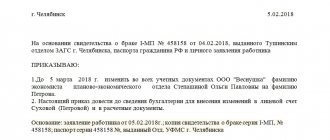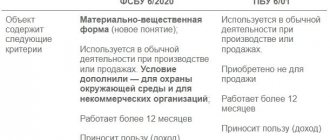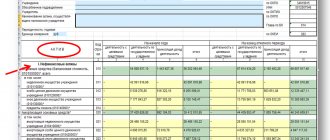Why do we need a nomenclature and an order for its approval?
To fully understand the role of the order, you should first understand the purpose of the nomenclature itself.
The nomenclature is a document that reflects a complete list of matters, including various types of internal papers of the organization.
It does not apply to strictly mandatory documents, and, as a rule, is widespread in large enterprises and government agencies. Representatives of small businesses acquire it much less often, which, in general, is quite understandable and logical.
In large companies with a large staff and many structural divisions, all documents are placed in certain folders, each of which is called a “case” . The number of such folders can reach several hundred .
In order to organize their accounting, a special document in which the following are entered:
- names of cases;
- date of commencement of their maintenance;
- shelf life;
- number of volumes, etc. information.
At the same time, the nomenclature includes those cases that are currently being conducted and those that are already somewhat outdated.
The nomenclature is a periodic document and is compiled, as a rule, once a year - usually in December, for the next year. This regularity allows the company administration to know exactly what documents the organization is entering the next reporting period with.
Sometimes, especially in budgetary institutions, after drawing up the nomenclature, it is agreed upon and approved by a specially created commission. However, in commercial structures, this rule is not always observed - here, quite often, the management of the enterprise makes do with only the appropriate approving order issued on behalf of the director.
The order not only puts the nomenclature into effect, but also makes it possible to ensure the obligation prescribed by law for the proper content and storage of current and archival files.
Drawing up an order
Approval of the organization’s list of affairs is the final stage of its development, which includes the following stages:
- Checking the availability and composition of cases in each division of the organization. The verification begins, as a rule, a month before the compilation of a new list of cases (it can be earlier, depending on the number of cases and departments). During the verification process, the number of volumes of each case is established and cases that were not conducted at all or were opened again are identified. This work is carried out jointly by the heads of services and the head of the office or archive.
- Drawing up a list of business units for the next year. This is also done jointly by the heads of services and the head of the office or archive. The result is a list of department affairs.
- Drawing up a consolidated nomenclature based on the nomenclatures of departments. We talked about the rules for its registration here.
- Issuance of an order approving the list of cases.
Who writes the order
The compilation of the nomenclature is usually carried out by a document specialist or a clerk, but writing an order approving it is the responsibility of another employee: most often this is a legal adviser, a personnel specialist or the secretary of the organization, i.e. a person vested with a certain kind of authority, having knowledge and skills in writing administrative documents.
At the same time, regardless of who was directly involved in creating the order, he must submit the document for approval to the director of the enterprise.
How best to update the list of cases for 2020 in connection with the entry into force of the new List
The new List of standard management archival documents generated in the course of the activities of state bodies, local self-government bodies and organizations, indicating their storage periods (approved by order of the Federal Archives of December 20, 2019 No. 236)1 came into force on February 18, 2020. As of this date, the organization should already have a case list for 2022; it should have been approved at the end of 2019 before the beginning of 2022. Therefore, the main task of the office management service is now to ensure compliance with the regulatory periods for storing documents in accordance with the new List. To solve it you need:
- Analyze the 2022 List, pay attention to its new thematic subheadings, categories and sets of documents that have appeared in comparison with the 2010 List2;
- Compare the storage periods for categories, complexes and types of documents established by the new List with the storage periods for specific case headings in the approved nomenclature of cases for 2020, identify any changes in terms;
- Clarify the wording of specific headings of cases in accordance with the composition of the documents in the new List and check the sequence of indexes (if necessary), enter new periods for storing documents, first of all, in the working copy of the nomenclature of cases maintained by the records management service. This instance will become the basis:
- to develop a new nomenclature for 2022 or changes to its original version (we will show how this can be done in detail and with examples below);
- to prepare for approval of the list of cases for the next 2021;
- Based on the working copy, determine the scope of necessary changes and clarifications that relate to specific case headings and their storage periods, show the working copy to the head of the organization and the chairman of the expert commission and, in agreement with them, decide whether the approved nomenclature of cases for 2020 will be subject to revision, re-registration and actually re-approval if many changes are identified. With minor changes (or in a small organization), a few clarifications regarding new retention periods and some case headings (if necessary) may be included in the normal course of action in the original 2022 case nomenclature. They can be:
- approve by order for the main activity, in the administrative part of the text of which a change in deadlines and clarification of specific headings should be recorded (for example, in the form “was” - “became” or as in Example 2), or
- first develop an addition to the list of cases as an independent document, and then approve it by order.
Methodological recommendations for the application of the Rules for organizing the storage, acquisition, recording and use of documents of the Archival Fund of the Russian Federation and other archival documents in government bodies, local governments and organizations (i.e. the Rules that were approved by order of the Ministry of Culture of Russia dated March 31, 2015 No. 5263) admit that the inclusion of new case headings in the nomenclature during the year does not require its re-coordination and approval (clause 1.1.1). We believe that this rule can also be applied in the event of a change in the storage period for documents. In addition, if the organization is the source of acquisition, and its approved nomenclature of files has already been agreed upon with the EPC of an archival institution or state (municipal) archive in a planned manner (i.e., once every 5 years), then additionally coordinate its adjustments (and not significant processing) with EPA will not be required when specifying shelf life. Please note that the Rules for Office Work in State Bodies and Local Government Bodies that have come into force (approved by Order of the Federal Archive of the Russian Federation No. 71 dated May 22, 2019) provide that the office work service has the right to draw up an addition to the nomenclature of cases as an independent document reflecting all changes in the composition of the headings cases that occurred during the calendar year (clause 6.17). This method can also be applied when registering a change in storage periods in connection with the entry into force of the new List for 2022.
The work of making changes to the approved nomenclature of cases for 2020 may turn out to be quite labor-intensive, so we recommend that the records management service formalize its stages and the interaction of divisions by order of the first manager, since he is responsible for the documentary fund and approves the nomenclature of cases.
And if the organization does not have a nomenclature of cases, then in connection with the new List and the approval of regulatory periods for storing documents, the time has come to develop it on the basis of the 2015 Rules and Methodological recommendations for their application.
In the process of implementing the 2022 List, it is necessary to take into account one more problem - the recognition as invalid1 of the previously valid List of standard management documents with storage periods, approved by order of the Ministry of Culture of Russia dated August 25, 2010 No. 558. Therefore, if the organization has not yet had time to approve inventories of cases and acts on the allocation for destruction of documents and cases for previous years, then they will be subject to a re-examination of the value of the cases and a change in their storage periods in accordance with the new List of 2022.
We also recommend informing (or better yet, training) those responsible for office work in structural divisions and heads of departments (especially in large organizations with branches and representative offices) in order to:
- before checking compliance and clarifying storage periods and before re-approving inventories and acts, no documents were allocated for actual destruction or taken to recycling points;
- after making the necessary changes to the nomenclature of files and receiving the corresponding extracts from it or an order to change the storage periods, on the covers of the files opened in the departments, those responsible for office work formalized the change in storage periods and/or other details (see Example 6).
The specific content of work to implement the 2022 List in the organization will depend on the volume of documents, cases and the number of identified changes that need to be made to the list of cases. Depending on this, the head of the organization (upon the recommendation of the head of the office management service) makes a decision on how to make changes to the nomenclature of cases for 2020. Next, we will consider examples of the design of texts of orders that the records management service will need to prepare in the process of changing the storage periods for documents in accordance with the new List of 2022.
Related material
Analysis of the new List of documents with storage periods and comparison with the 2010 List.
№ 05 / 2020
See the article “Analysis of the new List of documents with storage periods and comparison with the 2010 List” in No. 5′ 2020
Related material
Transfer of personnel documents to the archive upon liquidation of an organization (part 1)
№ 05 / 2020
See the article “Transfer of personnel documents to the archive upon liquidation of an organization” in No. 5′ 2020
Related material
2022 list of storage periods for accounting and tax documents
№ 07 / 2020
See the article “List of 2022 on storage periods for accounting and tax documents” in No. 7′ 2020
Related material
Local regulations: how to formulate them into files, how much to store, how to destroy
№ 03 / 2021
How to write an order: basic rules
There is no single standard for writing an order for approval of the nomenclature of cases, so companies can write it in any form or in a sample developed and approved in the company’s accounting policy. However, regardless of which method is chosen, a number of certain parameters should be included in the document:
- number and date of creation of the order;
- name of company;
- information about the approved nomenclature: its number, the year for which it was compiled and other information (if necessary);
- list of persons responsible for execution of the order.
It should be noted that any order must have some basis. In this case, it is enough to write something like: “In order to ensure standards for the content and storage of documents” or provide a direct link to the relevant law.
The procedure for developing a list of cases
Usually, as a basis for determining the structure (sections) of the organization’s nomenclature of affairs, they take the structure enshrined in its staffing table. The first section of the consolidated nomenclature is always the name of the preschool educational institution service: Administration, office, etc. The last section is the names of organizations or bodies operating on a voluntary basis.
In small organizations or in the absence of a stable structure, management functions or areas of activity become sections of the nomenclature, for example: Management, Personnel, Advertising activities, etc.
The nomenclature of files is compiled according to a unified form, which was developed by archival authorities and is currently enshrined in the Basic Rules for the Operation of Archives of Organizations. The form of the nomenclature of cases is a table of five columns (see Examples 2, 3). Each line of the tabular part of the nomenclature of cases is called an article and describes one case. Let's consider the features of filling out the columns of this table.
In column 1, enter the index of the case included in the nomenclature.
Case indices - symbols assigned to each case are of great importance for the practical use of the nomenclature (see column 1 of the nomenclatures in Examples 2 and 3). Arabic numerals are used to indicate case indices.
Typically, the case index consists of a digital designation of the structural unit, which is accepted in the organization, and the serial number of the case within the structural unit. For example, case index 02-04 means that the case was formed in a structural unit to which the index “02” was assigned, and in the nomenclature of cases of this unit, the title of the case is numbered “04”. It is recommended to maintain the same indexes for homogeneous cases formed in different structural divisions. For example, if the title of the case “Orders for core activities” in the “Office” section has an index of 01-05, in the “Financial Department” section this case should have an index of 03-05, in the “Planning and Economic Department” section - 04-05 and etc.
Indexation of structural units must be constant and repeated from year to year. Transferable cases are entered into the nomenclature each time under the same index.
If the nomenclature is built according to a production or functional scheme (that is, according to the main areas of activity), the case index will consist of the index of the activity area and its serial number in a given group of cases, for example: 03-02, where “03” is the designation of the activity issue ( for example, “Advertising”, “Finance”, “Personnel”, etc.), “02” is the serial number of the case within the section.
Indexes from the list of cases are then used when registering documents. For example, the 1st order for the main activity in 2010 may have No. 01-03/1, where “01-03” is the index of the case according to the nomenclature into which this order will be filed.
2 columns are the names of the headings of the cases (the rules for their compilation and systematization are discussed in detail below).
Column 3 indicates the number of cases (volumes of a specific case). The thickness of the case should not exceed 4 cm, which is approximately 250 sheets. If there are more sheets, then the case is divided into parts (volumes). Their exact number becomes known only at the end of the office (i.e. calendar) year, and this column is filled in at the end of the current year.
In column 4 “Storage periods and articles on the List” indicate the storage period of a specific case and the article of a specific list. A link to the name and output of the list itself is made on the first page of the list of cases.
Storage periods for files are set to ensure the safety of valuable documents. Retention periods are an important basis for grouping documents into files, since documents with a permanent storage period, storage periods of up to 10 years and over 10 years cannot be placed in one file.
The storage periods for documents - permanent or temporary (1 year, 3 years, 5 years, 10 years, 15 years, etc.) - are set depending on the significance of the documents. If the file contains temporary storage documents of varying value and, therefore, with different storage periods, the storage period of the entire file is established according to the most valuable documentation, i.e. more. For example, if the file contains documents with storage periods of 1 year, 3 years and 5 years, the entire file is stored for 5 years.
The retention period is calculated from January 1 of the year following the year of termination of the case. For example, the storage period for a case completed in 2009 will be calculated from January 1, 2010.
Some documents do not have specific storage periods, but are stored “until the need passes” (for example, documents from higher organizations sent for information) or “until they are replaced with new ones” (regulations, instructions). Then exactly these marks are placed in this column. An o may be indicated here, which means that at the end of the record-keeping year the case will undergo an examination of its value, as a result of which only some documents may be stored permanently.
The main aids in determining the storage periods for files are standard and departmental lists of documents indicating their storage periods.
Standard lists developed by archival institutions establish storage periods for documentation that is typical for most institutions, organizations, and enterprises. They reflect general functions and issues (organization of the management system, control, planning, accounting, reporting, financing, logistics, etc.). When determining the storage periods for documents, several types of standard lists can be used, for example:
- List of standard management documents generated in the activities of organizations, indicating storage periods (2000);
- List of standard archival documents generated in the scientific, technical and production activities of organizations, indicating storage periods (2007), etc.
Lists of standard management documents are normative documents, which means that the storage periods for documents specified in them cannot be violated (thus, an organization cannot store documents for less than the established period, although it has the right to increase this period).
However, standard lists cannot cover all the documentation of various industries. Therefore, on their basis, ministries and departments are developing departmental lists, including the most complete systematized listing of documentation of organizations and enterprises in certain industries. When determining the storage periods for documentation, they first use the departmental list, and in its absence, standard lists.
In joint-stock companies, in addition, it is very important to know and take into account the requirements for the storage periods of documents enshrined in the Regulations on the storage of documents in joint-stock companies.
In the last column “Notes”, notes are made about new cases, about the transfer of cases to the archive, about transferring (that is, not completed in a given year) cases, about the allocation of cases for destruction, etc.
How to place an order: basic rules
Today there are also no strict standards for the execution of an order: it can be written in handwritten or printed form, on a simple blank sheet of A4 or even A5 format, or on company letterhead.
It should be taken into account that the order must have the original signature of the head of the enterprise or another employee authorized to certify such documents.
It is possible to stamp an order with a seal, but it is not necessary, since it relates to the internal document flow of the organization; moreover, since 2016, the use of seals and stamps by legal entities has been abolished by law.
The entire period of validity of the order must be stored in a specially designated place, along with other administrative documents. After losing its relevance, it must be transferred to the company’s archive, where it must be kept for the period prescribed by law. Then it can be disposed of (also in a strictly defined order).
Sample order
At the beginning of the document indicate:
- name of the organization for which the order is created;
- order number for internal document flow;
- Date of preparation;
- the locality in which the enterprise operates.
After this comes the main part - first the basis for the order should be entered here, i.e. indicate the purpose of its creation. Further, following the word “I order”, the fact of approval of the nomenclature is recorded in separate paragraphs, instructions are given to the heads of structural units and a person responsible for the execution of the order is appointed. If necessary, this part of the document can be expanded by adding some additional instructions.
In conclusion, the order must be certified by the signature of the director, as well as the person responsible for its implementation.
Making an order
An order to approve the nomenclature of cases is drawn up according to the rules for issuing orders adopted in a particular organization. On our website you can find a form and a sample order for downloading and review.
The order is issued on the organization’s letterhead, if it uses it. If not, you will need to indicate in the header of the order:
- name and legal address;
- TIN, checkpoint.
The structure of the order is as follows:
- The word “Order” is located next to it;
- the line below is the name of the order. “On approval of the list of cases for the ___________ year”;
- the preamble contains references to departmental and other regulations on the basis of which the list of cases was developed and compiled;
- then the word “I order” is written in the center;
- Below is the essence of the order: “To approve and put into effect from January 1, __________ the nomenclature of cases No. ___ for the ___________ year”;
- the order specifies the persons responsible for communicating it to interested parties;
- the position and transcript of the signature of the head - the author of the order are indicated.
After signing, the order is assigned a date and number. The same mark (date, number) is made on the item itself in the “approved by order” field.
It is not necessary for managers to familiarize themselves with the order approving the nomenclature against signature. But it is recommended to organize the issuance of copies of the approved nomenclature (working copies) with the signature of the recipient. Therefore, you can combine familiarization with the order and receiving a copy of the nomenclature on the general familiarization sheet.




